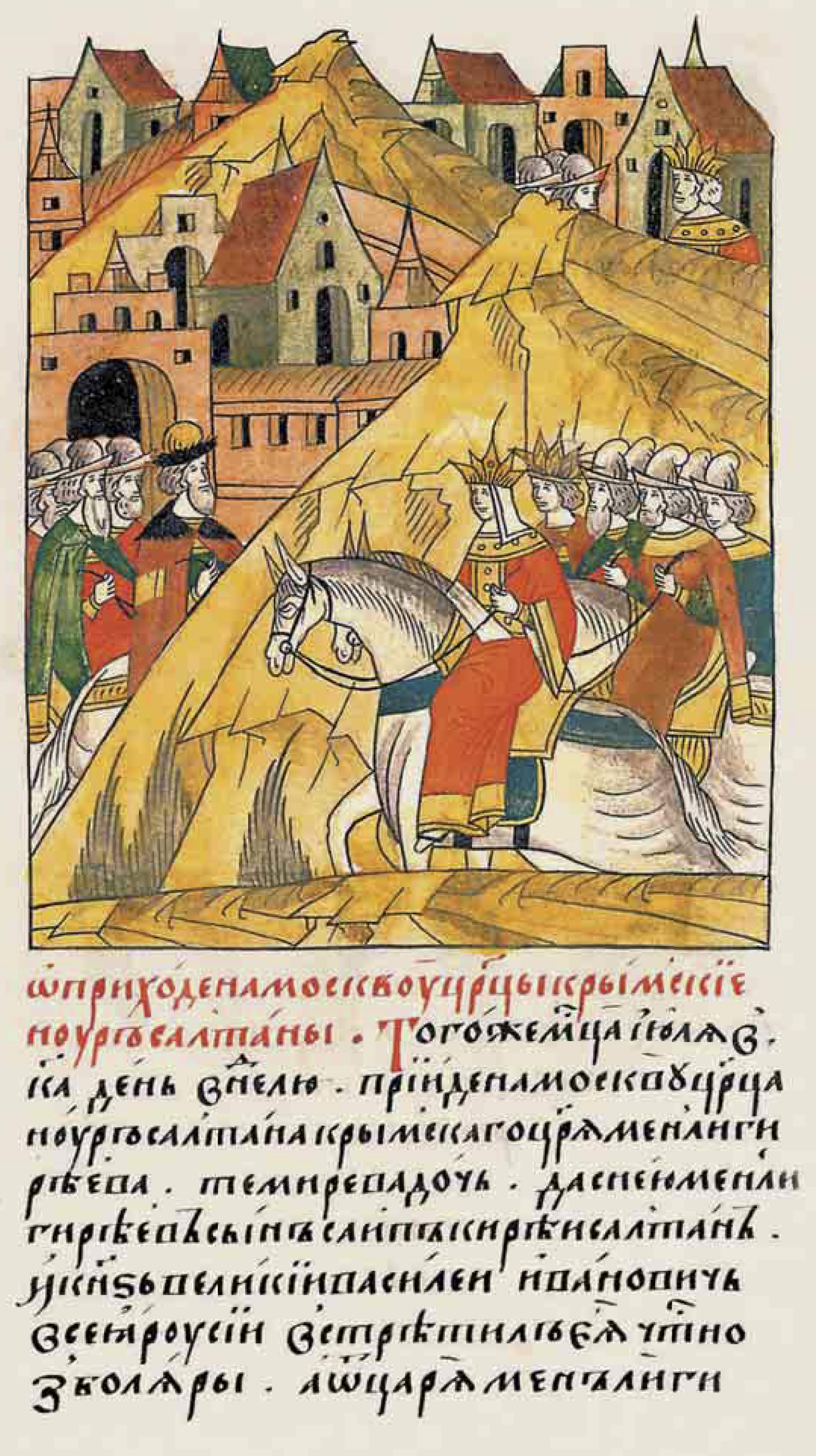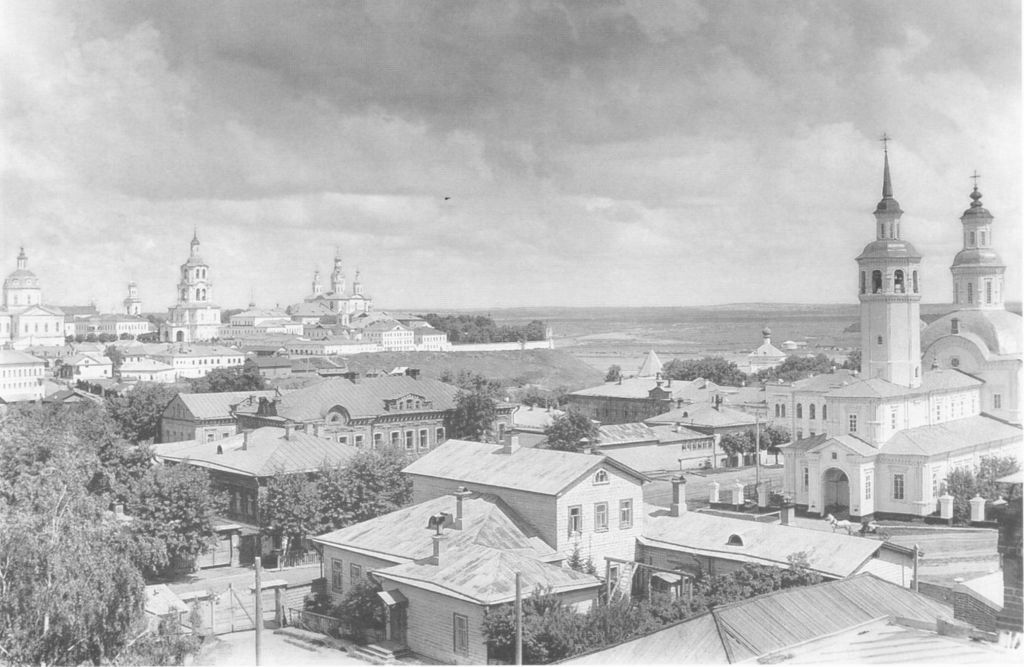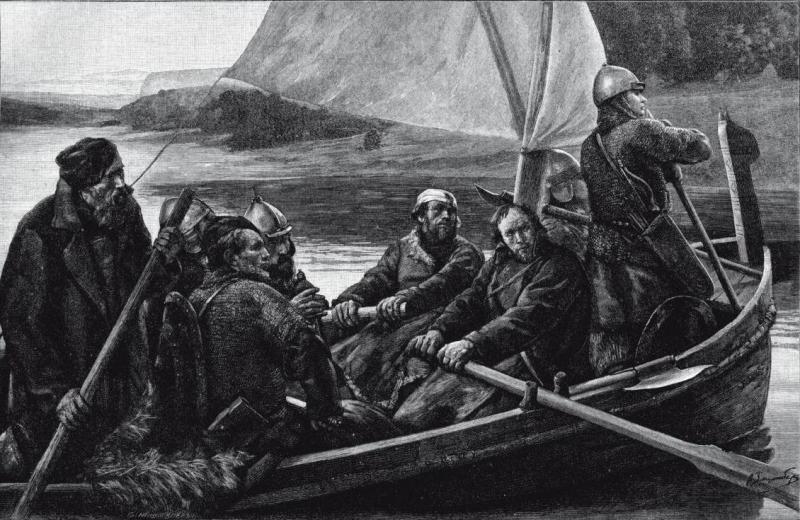|
Ibrahim Of Kazan
İbrahim khan (died 1479) was the Khan of Kazan from 1467. He was the son of Mäxmüd. He was crowned after Xälil's death and was married to Nursoltan. In 1467–1469 and 1478 he participated in wars against Muscovy. After concluding a treaty with Ivan III, all Russian prisoners of war held by the Khanate were released. He supported a policy of non-intervention into Muscovy's politics. Wars against Muscovy In 1467 Ivan III began to wage war against the Kazan Khanate. In the fall he sent as a pretender oglan Kasim, Ibrahim's uncle, which was supported by a part of Kazan nobility. Ibrahim destroyed numerous Muscovite forces in the battle on the Idel(Volga). At the head of opposition was mirza Gabgul-Mumin. The Russian campaign ended unsuccessfully, with the Russian army deciding to not cross the Volga to engage in combat with the Tatars. In response to this Ibrahim-khan in winter made a dragoon to the border areas of the enemy and plundered environs of Galich Merskoy. In 146 ... [...More Info...] [...Related Items...] OR: [Wikipedia] [Google] [Baidu] |
List Of Kazan Khans
List of Kazan khans who ruled the Khanate of Kazan before it was conquered by Russia. The First List has local spelling and dynasty. The Second List has very short biographies. First List *''Ghiasetdin of Kazan, Ghiyath-ud-din Khan taking advantage of the troubles of the Golden Horde established himself as an independent ruler of Kazan Ulus (Kazan district) during the 1420s. Eventually the former ruler of the Golden Horde, Olugh Mokhammad of Kazan, Ulugh Muhammad, would take over Kazan and establish his own separate Khanate of Kazan breaking the Golden Horde Empire.'' *''Blue rows signify influence of Grand Duchy of Moscow.'' **''Green row signifies brief interruption under Khan of Sibir Khanate.'' ***''Pink rows signify Qasim Khanate rule.'' ****''Yellow rows signify Giray dynasty from Crimean Khanate.'' *****''Brown row signifies prince from Khanate of Astrakhan rule.'' Second List with short biographies This information comes from Howorth's 1880 book Henry Howorth, History ... [...More Info...] [...Related Items...] OR: [Wikipedia] [Google] [Baidu] |
Xälil Of Kazan
Xalil (also ''Khalil, Halil, Chelealeck''; tt-Cyrl, Халил, pronounced ) (d. 1467) was the 3rd khan of the Kazan Khanate circa 1466–1467, but very little is known about him. He was the eldest son of khan Maxmud (Mahmudek, Mäxmüd) and grandson of the first Khan of Kazan, Ulugh Muhammad. He spent his life entirely in Kazan. He ascended to the throne after his father's death. He was succeeded by his brother Ibrahim. Reign Xälil continued his father's policy of construction of Kazan cities. Xälil was considered as an explosive and aggressive ruler. He was known for breaking the treaty with Duke-Prince Ivan III and poor relations with the Nogais. He later re-established ties with the Nogais upon marriage with Nur Sultan, daughter of Nogai Timur Mirza. In Russian chronicles, the name Xälil is not mentioned at all. However, his name is mentioned in the work of the traveler of the 16th century Sigismund von Herberstein "Notes on Muscovite Affairs" (''Rerum Moscovitic ... [...More Info...] [...Related Items...] OR: [Wikipedia] [Google] [Baidu] |
Ilham Ghali Of Kazan
Ilham (Ghali, Ali, Ilham, Aleham, Tatar: İlham, Ğäli) (c. 1449 – c. 1490) was a khan of Kazan Khanate in 1479–1484 and 1485–1487. For more see Möxämmädämin of Kazan. See also * List of Kazan khans List of Kazan khans who ruled the Khanate of Kazan before it was conquered by Russia. The First List has local spelling and dynasty. The Second List has very short biographies. First List *''Ghiasetdin of Kazan, Ghiyath-ud-din Khan taking advanta ... References * 1440s births 1490s deaths Khanate of Kazan 15th-century monarchs in Europe {{Russia-hist-stub ... [...More Info...] [...Related Items...] OR: [Wikipedia] [Google] [Baidu] |
Nur Sultan (wife Of Mengli I Giray)
Nur Sultan (1451–1519) was the wife of Mengli I Giray (r. 1467–1515). She was one of very few women known to have had influence over the affairs of state in the Crimean Khanate. She is also one of few well known women of the Giray dynasty. Life She was the daughter of Prince Timur ibn Mansur, bey of the Manghits.Ilya V. Zaytsev, ''The Structure of the Giray Dynasty (15th-16th centuries): Matrimonial and Kinship Relations of the Crimean Khans'' in Elena Vladimirovna Boĭkova, R. B. Rybakov (ed.), ''Kinship in the Altaic World: Proceedings of the 48th Permanent International Altaistic Conference'', Moscow 10–15 July 2005, p.341-2 She was the sister of Tevkel. She first married khan Xälil of Kazan (r. 1466-67). After his death, she married his brother Ibrahim of Kazan (r. 1467-1479). She became the mother of Möxämmädämin of Kazan and Ghabdellatif of Kazan. She supported the neutrality policy of her spouse against the more aggressive policy of her stepson Ilham Ghali. S ... [...More Info...] [...Related Items...] OR: [Wikipedia] [Google] [Baidu] |
Khan Of Kazan
List of Kazan khans who ruled the Khanate of Kazan before it was conquered by Russia. The First List has local spelling and dynasty. The Second List has very short biographies. First List *'' Ghiyath-ud-din Khan taking advantage of the troubles of the Golden Horde established himself as an independent ruler of Kazan Ulus (Kazan district) during the 1420s. Eventually the former ruler of the Golden Horde, Ulugh Muhammad, would take over Kazan and establish his own separate Khanate of Kazan breaking the Golden Horde Empire.'' *''Blue rows signify influence of Grand Duchy of Moscow.'' **''Green row signifies brief interruption under Khan of Sibir Khanate.'' ***''Pink rows signify Qasim Khanate rule.'' ****''Yellow rows signify Giray dynasty from Crimean Khanate.'' *****''Brown row signifies prince from Khanate of Astrakhan rule.'' Second List with short biographies This information comes from Howorth's 1880 book Henry Howorth, History of the Mongols,1880, part 2, pp 363-429 and ... [...More Info...] [...Related Items...] OR: [Wikipedia] [Google] [Baidu] |
Mäxmüd Of Kazan
Mäxmüd Khan (pronounced ); in Russian chronicles ''Махмутек (Makhmutek);'' ?-1466) was the Khan of the Khanate of Kazan from 1445-1466. He was the eldest son of Oluğ Möxämmäd, and is reputed to be one of the Khanate's founders. Mäxmüd participated in his father's military campaigns against Muscovy and in 1445 was victorious at the Battle of Suzdal, taking the Grand Duke of Moscow Vasily II captive and forcing Muscovy to pay tribute (yasak). After the death of Oluğ Möxämmäd, Mäxmüd succeeded to the throne of Kazan. In December 1446 he supported Vassily II in dethroning Dmitry Shemyaka. In 1448 Mäxmüd attacked Moscow to preserve advantageous treaty conditions that were concluded after the battle of Suzdal. In that period, the Qasim Khanate, governed by Mäxmüd's relatives, was created as a buffer state A buffer state is a country geographically lying between two rival or potentially hostile great powers. Its existence can sometimes be thought to prevent ... [...More Info...] [...Related Items...] OR: [Wikipedia] [Google] [Baidu] |
Grand Duchy Of Moscow
The Grand Duchy of Moscow, Muscovite Russia, Muscovite Rus' or Grand Principality of Moscow (russian: Великое княжество Московское, Velikoye knyazhestvo Moskovskoye; also known in English simply as Muscovy from the Latin ) was a Rus' principality of the Late Middle Ages centered on Moscow, and the predecessor state of the Tsardom of Russia in the early modern period. It was ruled by the Rurik dynasty, who had ruled Rus' since the foundation of Novgorod in 862. Ivan III the Great titled himself as Sovereign and Grand Duke of All Rus' (russian: государь и великий князь всея Руси, gosudar' i velikiy knyaz' vseya Rusi). The state originated with the rule of Alexander Nevsky of the Rurik dynasty, when in 1263, his son, Daniel I, was appointed to rule the newly created Grand Principality of Moscow, which was a vassal state to the Mongol Empire (under the "Tatar Yoke"), and which eclipsed and eventually absorbed its parent duchy ... [...More Info...] [...Related Items...] OR: [Wikipedia] [Google] [Baidu] |
Ivan III Of Russia
Ivan III Vasilyevich (russian: Иван III Васильевич; 22 January 1440 – 27 October 1505), also known as Ivan the Great, was a Grand Prince of Moscow and Grand Prince of all Rus'. Ivan served as the co-ruler and regent for his blind father Vasily II from the mid-1450s before he officially ascended the throne in 1462. He multiplied the territory of his state through war and through the seizure of lands from his dynastic relatives, ended the dominance of the Tatars over Russia, renovated the Moscow Kremlin, introduced a new legal codex and laid the foundations of the Russian state. His 1480 victory over the Great Horde is cited as the restoration of Russian independence, 240 years after the fall of Kiev in the Mongol invasion of Kievan Rus'. Ivan was the first Russian ruler to style himself "tsar", albeit not as an official title. Through marriage to Sofia Paleologue, he made the double-headed eagle Russia's coat of arms and adopted the idea of Moscow as Third Ro ... [...More Info...] [...Related Items...] OR: [Wikipedia] [Google] [Baidu] |
Ivan III
Ivan III Vasilyevich (russian: Иван III Васильевич; 22 January 1440 – 27 October 1505), also known as Ivan the Great, was a Grand Prince of Moscow and Grand Prince of all Rus'. Ivan served as the co-ruler and regent for his blind father Vasily II from the mid-1450s before he officially ascended the throne in 1462. He multiplied the territory of his state through war and through the seizure of lands from his dynastic relatives, ended the dominance of the Tatars over Russia, renovated the Moscow Kremlin, introduced a new legal codex and laid the foundations of the Russian state. His 1480 victory over the Great Horde is cited as the restoration of Russian independence, 240 years after the fall of Kiev in the Mongol invasion of Kievan Rus'. Ivan was the first Russian ruler to style himself "tsar", albeit not as an official title. Through marriage to Sofia Paleologue, he made the double-headed eagle Russia's coat of arms and adopted the idea of Moscow as Third Rom ... [...More Info...] [...Related Items...] OR: [Wikipedia] [Google] [Baidu] |
Khlynov
Kirov ( rus, Ки́ров, p=ˈkʲirəf, a=Ru-Киров.ogg) is the largest city and administrative center of Kirov Oblast, Russia. It is located on the Vyatka River in European Russia, 896 km northeast of Moscow. Its population was 518,348 in 2020. Kirov is a historical, cultural, industrial, and scientific center of Priural'e (territory on the west side of the Ural Mountains); place of origin for Dymkovo toys; the most eastern city founded during the times of Kievan Rus'. The city also had the names of Khlynov (, from 1457 to 1780), and Vyatka (, until 1934). History Principality and republic The native Slavic tribe of Central Russia and Volga regions, the Vyatichis (also called Viatichi), mixed here with the Novgorodian Slovenes and Finno-Ugric people. According to the medieval chronicles the first Russian settlements in the area appeared in 12th century. Kirov itself was first mentioned (as Vyatka) for the first time in 1374 when Novgorod ushkuyniks plu ... [...More Info...] [...Related Items...] OR: [Wikipedia] [Google] [Baidu] |
Ushkuynik
Ushkuyniks (russian: ушкуйники), also ushkuiniks were medieval Novgorodian pirates which operated along the Volga River, the eastern part of Scandinavia, and north of the Ural mountains in 12th-15th century. Some historians see them as a continuation of Viking traditions of ancient Rus' people. Etymology The word is derived from the (russian: ушкуй), the type of ship they used. These ships could be easily transported over portages between watersheds. The word likely derives either from Oskuya river, or from Old Veps “*uškoi̯” (small boat). History Novgorodians took part in the Tsargrad expeditions of the 10th century and other raids on Byzantine Empire, mounted pillaging raids to Finland since 12th century (see Swedish–Novgorodian Wars),including seizing its capital - Turku. Ushkuyniks first appear in the historical record as an organized force in the 1320s. Arranged in squadrons which could number several thousand, Ushkuyniks enjoyed the patron ... [...More Info...] [...Related Items...] OR: [Wikipedia] [Google] [Baidu] |
Vyatka Land
Vyatka Land was a part of Medieval Russia in the basin of the Vyatka river, approximately corresponding to the modern Kirov Oblast. Permian people were its original inhabitants and it was gradually settled by Russians whose arrival is traditionally dated to the late 12th century. Vyatka Land, being geographically isolated from the rest of the Russian lands, sometimes accepted the suzerainty of other Russian and Tatar states but de facto had a large degree of independence until it was annexed by the Grand Duchy of Moscow in 1489. History Udmurts inhabited the Vyatka land before the arrival of Russian settlers. According to the Legend of the Vyatka Land they came from Novgorod in 1174, conquered Kotelnich and Nikulitsyn with the supernatural help of saints Boris and Gleb and founded Khlynov which became the main settlement of the Vyatka land (often called ''Vyatka'' as well). This account was disputed by some historians who consider the Legend to be a much later and unreliable ... [...More Info...] [...Related Items...] OR: [Wikipedia] [Google] [Baidu] |





